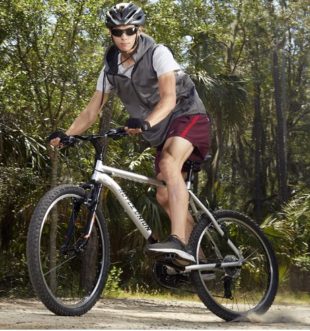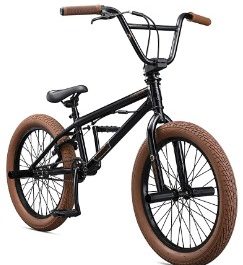Cycling is a low-impact and low-injury sport. It aids in strengthening your leg joints and muscles, giving you an overall healthy knee. But as it’s highly repetitive, you may ask, is cycling bad for knees?
According to a 2017 Journal of Community and Family Medicine research, 16% of pro and 27% of beginner riders experience mild knee pain at one point in their cycling career. That shows that cycling isn’t 100 knee pain-free.
But comparing the numbers, the percentage of those who suffer knee pain to those who don’t is smaller. And for that reason, we can argue that cycling isn’t bad for the knees.
Cycling is a low-impact form of sport that helps in giving flexibility to the joints, strengthens your core and leg muscles, and enables you to shed some pounds.

But What Causes Knee Pain, Given That Cycling Is Low Impact?
Well, if you encounter knee pain after prolonged cycling, it could be caused by riding harder, longer, and faster, or you don’t warm up before starting your ride. It could also be that you have the wrong bike size, poor riding posture or are using low cadence.
I’ll explain the types of cycling-related knee pain, their causes, and what you can do to cycle with a pain-free knee. I’ll also recommend the best bikes you can use when experiencing knee pain.
Let’s get started!
But first, let’s answer two critical questions on knee pain based on research;
Is Cycling Good for Arthritic Knee?
According to Permanente Journal, cycling reduces joint pressure and brings overall wellness to people suffering from osteoarthritis. Since cycling is a low-impact sport, it will help your knees by relieving the pain and allowing them to flex.
That makes it good for the arthritic knee. But again, it has to be moderate cycling and not intense cycling.
Is Too Much Cycling Bad for Knees?
According to the Body Mechanic, an Australian-based physiotherapy practice, ‘cycling is a highly repetitive sport, with a rider averaging about 5,000 pedal strokes per hour.’
That said, too much cycling may cause knee pain. To avoid such an occurrence, you should cycle moderately, mainly if you are a beginner.
Types of Knee Pain Related to Cycling
Here are four types of cycling-related knee pains:
a) One-Knee Pain
Pain on one knee is widespread among biking enthusiasts who ride their bikes asymmetrically. That is a riding position whereby you ride with the wrong setup bike. So, if you experience pain in one knee, the culprit to check is the saddle.
If the saddle is raised so high, you’ll likely lean on one side and sacrifice your other leg to pain and discomfort. So, if this sounds like your case, ensure you lower the bike seat to an ideal position.
b) Behind Knee Pain
Like in the first case, when your saddle is too high, your hip will experience a certain degree of discomfort as you strain to pedal hard.
Also, if your saddle is too far at the back, you will likely strain your hip muscle to reach the pedal. In turn, the pain will concentrate at the back of your knee.
So, if you experience back knee pain, you should ensure you adjust the seat by lowering or moving it forward.
c) Kneecap Pain
Kneecap pain is prevalent among many beginners and experienced riders. If you experience kneecap pain, it’s likely to mean one thing – your bike saddle is too low or too forward.
To correct this, you should adjust the seat by raising its height or moving it back a little.
d) Side Knee Pain
The last knee pain you are likely to experience is at the side of the knee. A high saddle usually causes side knee pain.
So, you can check the seat, and if it’s too high, you can adjust it by lowering it to the correct height you are comfortable with.
Causes of Knee Pain When Cycling
As seen above, knee pain is mainly due to poor posture and incorrect bike size. However, other factors can also contribute to knee pain. They include:
1. Riding Faster, Longer, And Harder
Asa newbie, you may assume that getting on a bike and hitting the 60 miles is an easy task. So, you may try riding faster for long hours and much harder.
Unfortunately, that will strain your knees’ connective tissues, and you will likely have knee pain. To avoid this, you should increase the mileage progressively.
It simply means you should be prudent, especially when adding the mileage. Start slowly and appreciate yourself in every milestone.
2. Not Warming Up
Every biking enthusiast will tell you that warming up is crucial before jumping on the bike. So, before starting, ensure you have at least 5-10 minutes to warm up. That is essential in cycling and other sports like climbing, running, or football.
However, many beginner riders forgo this part, and the consequence is terrible knee pain. Warming up helps strengthen your arms, legs, and hip muscles. It also increases oxygen intake, which is excellent when cycling.
So, if you fail to warm up, you can correct that by starting cycling slowly as you increase your speed. If you start riding faster, you will likely have bad back, leg, arm, hip, or knee pain.
3. Incorrect Bike Fit
Poor fit does not necessarily mean helmets or shoes but also the bike itself. A poor bike fit means the cycle may be too small or too big for you.
But how can you know if your bike is the correct fit for you?
You should check this by putting one pedal at six o’clock and the other at twelve o’clock. If the leg on the lower saddle isn’t straight, the bike is a poor fit for you.
If you have an adjustable seat, adjust it by lowering or raising it until your lower leg is straight. You will likely experience front and back knee pain if the bike is not your correct fit.
4. Poor Riding Posture
The bike riding posture is detrimental to a pain-free knee. If you ride in a slouching posture or an overextended manner, you will likely not have great hand, arm, and leg positioning and will experience knee pain.
Though different people may have different riding positions, you can achieve an overall great posture by following the guidelines below:
- Put your back in an aerodynamic position or otherwise straight. Don’t, however, round your back as it may cause spine pain.
- Relax your shoulders. If you push your shoulders up, you will put too much pressure on them, which will eventually cause back and knee pain.
- Bend your elbows a little bit rather than having them straight
- Avoid knee collapse. Remember, cycling is a repetitive sport that can cause painful knee collapse. So, start slowly.
5. Low Cadence
The time you pedal per minute is calculated in cadence (rpm-revolution per minute). For example, a cadence of 50 means achieving 50 revolutions each minute. However, cadence goes hand in hand with your cycling gear, which dictates your speed.
A low cadence (below 60 rpm) usually strains your knees as it needs more energy to pedal. So, it’s advisable to keep a tempo of 60rpm+ not to push your knees.
How to Adjust Your Bike to Fit Properly (Not to Hurt Knees When Cycling)
Poor riding posture and incorrect bike size have a big say in knee pains. But to avoid the occurrence of knee pain, you can adjust the saddle and the cleats as explained below:
· The Cleats
If you ride with your one leg unstraight, it’s likely that the cleats are too tight and make your legs hang in an unnatural position (either too inwards or too outwards), which will automatically translate to knee pain.
So, if this is your case, you need to loosen pedal tension so that your feet can slack a little bit and enable you to ride in your natural posture.
· The Saddle
Adjusting the saddle is easy; you can do it by changing its front part or height. You will likely ride with a low saddle if you are a beginner.
While this routine allows you to place your feet flat on the ground, it does not give you enough flexibility to your knees and will lead to sharp kneecap pain.
If this sounds like your experience, you can raise the saddle height until the foot on the lower pedal is in the 6 o’clock position.
After raising the seat, the saddle positioning is next to check (whether it’s too back or too forward). So, adjust it until the kneecap of the front leg is on top of the ball of the foot.
Also, ensure that you can hold the handlebar without strain.
Benefits of Cycling to The Knees
If you warm up and have a bike that suits you properly, cycling can bring great results to your knees. Below are just a few benefits of cycling to the knees:
a) Knee Muscle Strengthening
You build and strengthen your knee muscles every time you ride a bike. That doesn’t just apply to seniors but kids too.
That means if you have a young one with a bad knee, you should let them exercise with a bike that fits their needs and keeps their knees in motion.
One bike that suits kids with bad knees is the Mobo Triton Pedal Go Kart Trike. This outdoor bike fits kids from 7 – 12 years and has a well-cushioned seat for good comfort.
b) Good for Osteoarthritis
Are you a senior who is suffering from arthritic knees? Well, you should know that one big threat to arthritis is being overweight. So, if you are also heavy, your arthritic knees will become extremely painful.
But if you exercise cycling regularly, it will reduce knee pain and help you shed some pounds. In this case, for your colossal weight and considering you are a senior, you can embrace the HARISON Magnetic Recumbent Bike.
This indoor recumbent bike can hold up to 350 lbs. and comes with 14 resistant levels that allow you to adjust the tension according to the knee exercise you want.
What to Do When Experiencing Cycling Knees Pain
If you have a bad knee from cycling, it doesn’t mean your cycling career is over. Your knee muscles will strengthen over time.
If the pain is too much, you can consult your doctor, but if it’s mild, you can use Glucosamine Chondroitin Turmeric MSM Boswellia. This joint discomfort relief comes in a bottle pack with 90 capsules and is a typical adult dietary supplement.
If taking tablets is not your thing, you can use NEENCA Professional Knee Brace. This knee support looks like a bandage and helps relieve pain when cycling with an arthritic knee.
But if you don’t like cycling outdoors, there’s a suitable solution. There is a bike that gives you the freedom to allow your knees to flex without straining the knee muscles and joints in the comfort of your home.
The Marcy Regenerating Recumbent Exercise Bike is what to get. This bike has an adjustable seat, computer LCD, recumbent handlebars, straps on the pedals to secure and protect your leg, and wheels for stress-free transportation.
In Conclusion – Is Cycling Bad for Knees?
Cycling is a low-impact and effective way to keep your knees in motion. It helps strengthen the core and knee muscles and joints, helping you attain maximum flexibility.
However, if you cycle faster, longer, and harder, don’t warm up, have the wrong size bike, ride in a poor posture or use low cadence, you are likely to experience knee pain at some point.
Also Read:


